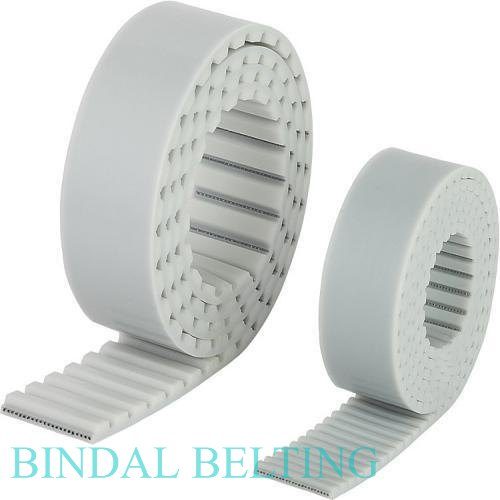
Open End Timing Belt
| Price per Unit | Meter |
| Type | Single Sided |
| Size | 21/32” |
| Brand | BRECO GERMANY |
| Material | PU |
| Usage/Application | Industrial |
| Color | White |
| Outer Measurement | 50-100” |
| Structure | Belt Conveyor |
| Pitch | H, L, T5, T10, AT5, AT10, 5M, 5M PAZ, 8M, 8MPAZ, 14MPAZ |
BINDAL BELTING provides high quality PU (Polyurethane) Timing belts in OPEN ROLL from world-leading German brands –
BRECO®, GERMANY.
BINDAL BELTING can provide the timing belts in open roll form, and provide V-jointing as per need.
Features:
- Durable finish standards
- Superior performance
- Hydrolysis-resistant
PU Timing Belt -open roll / V Joint are available in various standard profiles as below:
Open End Timing Belt
| Price per Unit | Meter |
| Type | Single Sided |
| Size | 21/32” |
| Brand | BRECO GERMANY |
| Material | PU |
| Usage/Application | Industrial |
| Color | White |
| Outer Measurement | 50-100” |
| Structure | Belt Conveyor |
| Pitch | H, L, T5, T10, AT5, AT10, 5M, 5M PAZ, 8M, 8MPAZ, 14MPAZ |
BINDAL BELTING provides high quality PU (Polyurethane) Timing belts in OPEN ROLL from world-leading German brands –
BRECO®, GERMANY.
BINDAL BELTING can provide the timing belts in open roll form, and provide V-jointing as per need.
Features:
- Durable finish standards
- Superior performance
- Hydrolysis-resistant
PU Timing Belt -open roll / V Joint are available in various standard profiles as below:
Open-end timing belts are critical components in synchronous power transmission systems, characterized by their toothed design and precise timing capabilities. These belts feature evenly spaced teeth along their inner circumference, which engage with corresponding pulley teeth to ensure accurate power transmission and synchronization. Constructed from materials such as rubber, neoprene, or polyurethane, open-end timing belts offer excellent resistance to wear, oil, and temperature fluctuations, making them suitable for a wide range of industrial applications.
Industries such as automotive, robotics, packaging, and textile manufacturing rely on these for their power transmission needs. In automotive applications, these belts are commonly used in engine timing systems to synchronize the rotation of the crankshaft and camshaft, ensuring precise valve timing and optimal engine performance. Similarly, in robotics, open-end timing belts provide reliable motion control for robotic arms and mechanisms, enabling precise positioning and movement. In packaging machinery, they facilitate the synchronized operation of conveyor belts, filling stations, and sealing mechanisms, ensuring efficient and accurate packaging processes. Additionally, in textile manufacturing, open-end timing belts drive the rotation of rollers and spindles in weaving and spinning machines, contributing to the production of high-quality textiles.
The advantages lie in their precise timing capabilities, durability, and versatility. Their toothed design ensures accurate power transmission and synchronization, even in high-speed or high-torque applications. Additionally, open-end timing belts offer low maintenance requirements and high efficiency, contributing to cost savings and operational reliability. Moreover, their resistance to wear, oil, and temperature fluctuations makes them suitable for demanding industrial environments, ensuring long-lasting performance and minimal downtime.
Key parameters for the design include pitch, width, tooth profile, and material selection. Pitch refers to the distance between tooth centers and determines the belt’s timing characteristics, with options including MXL, XL, L, and H pitches to accommodate different torque and speed requirements. Width is chosen based on the pulley width and load capacity, while tooth profile options such as trapezoidal or curvilinear influence the belt’s engagement and performance. Material selection depends on factors such as operating conditions, load requirements, and environmental considerations, with options including rubber, neoprene, or polyurethane compounds.
In conclusion, they are indispensable components in synchronous power transmission systems, offering precise timing, durability, and versatility across various industries. Their toothed design, resistance to wear, and high efficiency make them ideal for applications requiring accurate motion control and synchronization.

